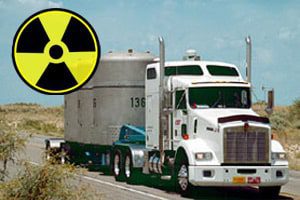
In 2012, some 1,000 trucks that were transporting tons of fracking waste from the Marcellus Shale tipped radioactivity alarms. About 15,769 tons of Marcellus Shale waste were stopped at a landfill in Pennsylvania after the waste material tripped radioactivity alarms at the gate, according to The Pittsburgh Post-Gazette. The trucks were not permitted to enter […]
 In 2012, some 1,000 trucks that were transporting tons of fracking waste from the Marcellus Shale tipped radioactivity alarms.
In 2012, some 1,000 trucks that were transporting tons of fracking waste from the Marcellus Shale tipped radioactivity alarms.
About 15,769 tons of Marcellus Shale waste were stopped at a landfill in Pennsylvania after the waste material tripped radioactivity alarms at the gate, according to The Pittsburgh Post-Gazette. The trucks were not permitted to enter the landfill; hand-held wand detectors revealed radioactivity in the contents. About 622 tons were sent to three out-of-state landfills that were equipped to dispose of materials that are deemed hazardous and/or radioactive. The remainder was deemed safe for burial with other waste as long as the waste remains below the annual limit set by the Department of Environmental Protection (DEP).
The increase in radioactivity of fracking waste is being seen at the same time that increased fracking is occurring at the Marcellus Shale. The radioactivity increases at the Shale have prompted DEP’s launch of a year-long study of radioactive Marcellus waste to gain some understanding of any risks tied to waste disposal, The Pittsburgh Post-Gazette reported. In response, the DEP’s bureau of waste management created a working group to develop protocols for tracking rejected loads, advise gas operators how to identify waste, develop landfill waste acceptance criteria, and describe the ways in which well sites and waste treatment plants handle residual waste.
The alarms flagged about 1 percent of all Marcellus waste scheduled for transportation to landfills in 2012, according to state figures. Most waste consisted of drill cuttings (pieces of earth pulled during drilling), well flow-back water, fracking sand, and fluids turned into sludge for disposal. It is the sludge that is believed to be contributing to increased radiation, according to The Pittsburgh Post-Gazette.
Fracking drilling involves the drilling injection of massive amounts of water, sand, and a mix of more than 600 chemicals underground via a concrete well that extends to an underground bed of shale rock. When this combination reaches the rock, it is blasted apart and natural gas is released and supposed to be returned to the surface and captured.
Fracking critics have long argued that fracking devastates the environment and contaminates groundwater and underground water aquifers; this contaminates nearby and widespread fresh water supplies. Either through the fault of shoddy wells, poorly trained well workers, or through a questionable drilling process altogether, natural gas and the contents of the drilling fluid may be released underground through cracks in the wells or the fractures created by the drilling. This, many area residents closest to wells believe, has led to a contamination of their private water supplies, in some cases rendering water completely contaminated.
The massive Marcellus shale formation is thought to contain billions of dollars in natural gas reserves. As gas drilling has expanded and thousands of wells have been opened in just the last few years surrounding areas, residents from New York, Pennsylvania, Ohio, Maryland, West Virginia, and New Jersey have raised concerns over the safety of fracking drilling.
While some believe fracking is an answer to a downturned economy and energy independence, more believe the drilling is putting the fresh water supplies for millions of people at risk. The risk is greater for those living closest to the drilling boom.


